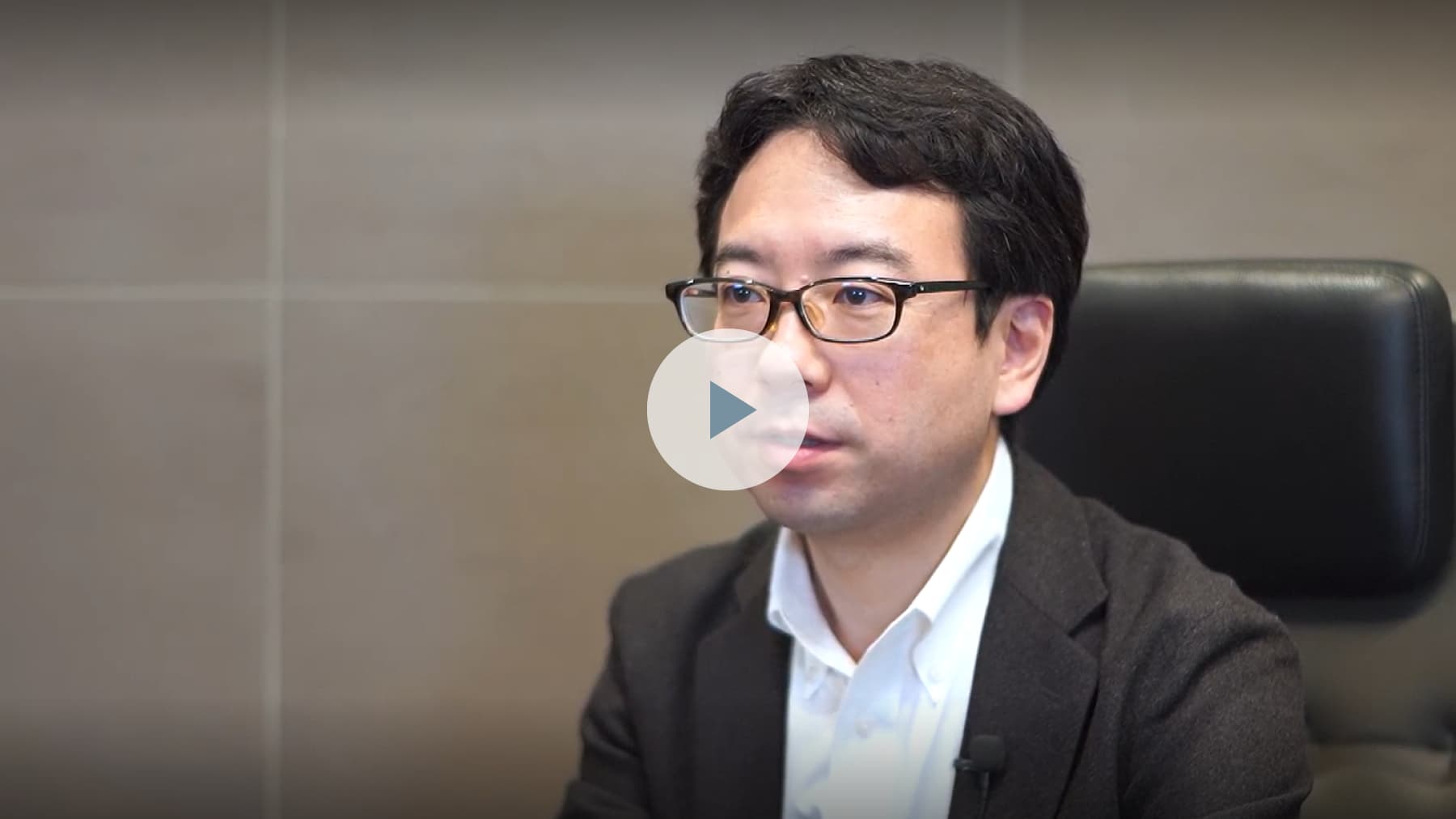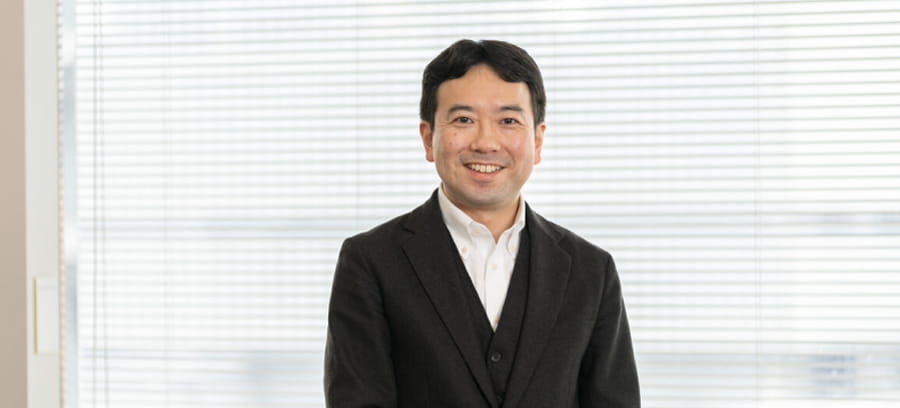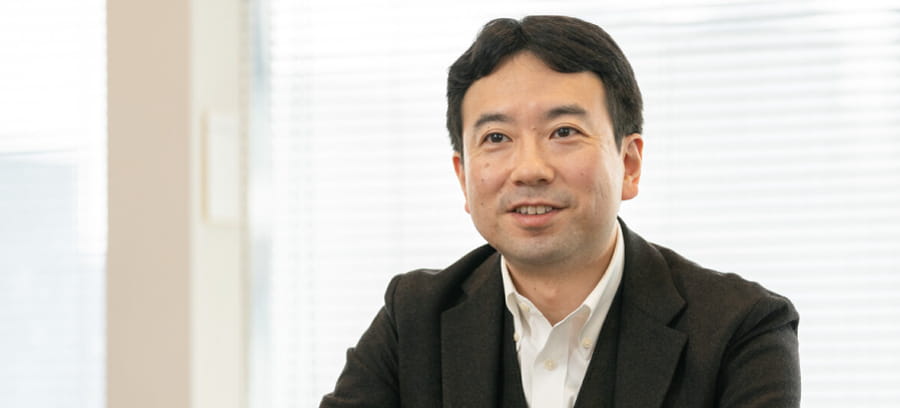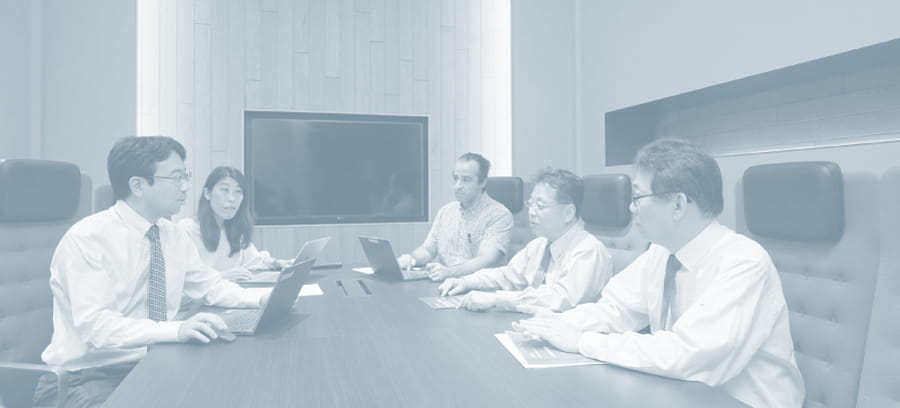TOP INTERVIEW
Our Goal to Bring Corneal
Transplant Treatments
Using iPS Cells
to Patients Around the World.
Our CEO, Shin Hatou, shares his vision for the future
in a video interview,
including our goal to bring corneal
transplant treatments to patients around the world.
We invite you to watch the interview to learn more.

Aiming to Provide a Breakthrough Corneal Transplantation
Therapy to Waiting Patients Worldwide by Efficiently
Producing Corneal Endothelial Cells Substitute from iPS Cells
– Cellusion Inc.
While approximately 13 million patients worldwide are
waiting for corneal transplants,
only about 180,000
transplants are performed each year,
creating a treatment supply-demand gap.
Cellusion Inc. has succeeded in mass-producing cells
from iPS cells to replace corneal endothelial cells.
This has accelerated efforts to conquer
the difficult-to-treat bullous keratopathy by eliminating the donor shortage,
shortening the time required for surgery,
and reducing the risk of complications.
We interviewed Founder and CEO, Dr. Shin Hatou,
who is also an experienced ophthalmologist.
This interview has been reprinted with permission
from LINK-J.
The contents are based on information
originally published as of May 27, 2022.

Shortage of Eye Banks and Skilled Surgeons a Challenge as 13 Million Patients Await Corneal Transplants
― What led you to start Cellusion?
HatouSince graduating from Keio University School of Medicine in 1998, I have specialized in corneal transplants as a clinical ophthalmologist. Corneal transplantation is the oldest of all transplantation procedures and has been performed for more than 100 years. While surgical techniques have advanced, the potential complications and a worldwide shortage of donors make corneal transplantation a treatment method with many issues to be solved.
In parallel with my clinical activities as a doctor, I have been conducting doctoral research on regenerative medicine for the cornea, especially since the discovery of iPS cells by Dr. Shinya Yamanaka. Since then, I have been studying the possibility of using iPS cells for corneal endothelial regenerative medicine. We decided to pursue the practical application of the technology and established Cellusion Inc. in 2015.
― Please tell us about the disease, bullous keratopathy, and how many people undergo corneal transplants.
HatouMore than half of all corneal transplant patients suffer from bullous keratopathy, which is caused by corneal endothelial cell dysfunction. There are two major factors that contribute to the development of bullous keratopathy: hereditary disease and complications. Hereditary bullous keratopathy is represented by Fuchs’ corneal endothelial degeneration, a type of corneal dystrophy, which begins to develop around age 50 or 60. As for complications, bullous keratopathy can occur due to severe trauma to endothelial cells during cataract, glaucoma, or other intraocular surgery. The factors that lead to the development of this disease differ slightly from country to country. In Europe and the U.S., hereditary disease is more prevalent, while in Japan and Asia, it often occurs as a complication from cataract or other intraocular surgery. Currently, there are approximately 13 million patients waiting for corneal transplants. Not only are donors in short supply, but there is also a shortage of eye banks to deliver corneas from donors to patients. Eye banks are not well established in all parts of the world as they require cultural maturity and a certain level of available medical care. Furthermore, there is a lack of ophthalmologists who can perform transplants. Corneal transplantation is one of the most difficult ophthalmological procedures and can only be performed by surgeons who have undergone specialized training. Because of these three factors, a mere 180,000 corneal transplants are performed globally each year, creating a large corneal transplant supply-demand gap and resulting in an unmet medical need for this type of therapy.
― Is the rejection in corneal transplants not as strong as other types of transplantation?
HatouCorneal transplants have been performed for over 100 years. The incidence of rejection is lower than that of other organs because the cornea is a transparent tissue with no blood vessels. Over its long history, we have accumulated knowledge on how to deal with rejection when it occurs. Specifically, steroid eye drops are used to reduce swelling and inflammation and for immunosuppression after corneal transplantation. For this reason, corneal transplants do not require blood type or HLA (human leukocyte antigen) matching. Corneal transplants from overseas donors of different ethnicities are commonly performed in Japan. Of course, there is no guarantee that rejection will not occur, but the percentage is small, and methods for managing it have been established.
― In the case of treatment using CECSi cells, there is the issue of HLA, but corneal transplants are suitable for regenerative corneal endothelial cell medicine, right?
HatouYes. Corneal transplants are possible because. In addition to being less prone to rejection, the environment inside the eye is immune-tolerant. The cornea is composed of three layers: epithelial cells on the top surface, stromal cells in the center, and endothelial cells on the bottom surface. Although each layer is different, rejection of endothelial cells, in particular, can be easily managed. This means that treatment in the form of allogeneic transplantation offers the best chance of success.
Refining Our Method for Producing CECSi Cells from iPS Cells Using Our Proprietary Technology
― You started your business in 2015, but how much progress had you made at that point?
HatouThe company was founded at a stage when treatment using CECSi cells was beginning to show signs of efficacy in small animals such as rabbits and cell production prototypes. After that, we continued to accumulate basic data that would serve as the foundation of our business. Next, we envisioned where we wanted to take the company, and in 2019 we received the Seed-stage Technology-based Startups (STS) grant from the New Energy and Industrial Technology Development Organization (NEDO) based on our business model and research data. It took us quite some time since we had been collecting basic data in order to obtain a large amount of funding. In the meantime, we focused on developing the product using public research funds obtained from the Keio University laboratory, with such efforts predominantly being carried out by me until 2019.
― What has been the most significant milestone in your journey?
HatouOne is that we carefully examined the production method and technology for inducing differentiation from iPS cells to CECSi cells, always keeping in mind the practical application of the technology. The original manufacturing method followed a step-by-step embryological process, whereby iPS cells were first differentiated into intermediate stem cells, then into progenitors, before finally being induced to differentiate into CECSi cells, the final tissue. However, this approach was insufficient to produce a large quantity of endothelial cells, even if iPS cells were scalable, and involved a long and complicated manufacturing process. To solve this problem, we developed a new manufacturing method to induce differentiation of endothelial cells directly from iPS cells, which enables cell differentiation in a shorter time and is more convenient. This method is highly robust, suitable for quality control, and eliminates the challenges in technology transfer from our laboratory to a Contract Development and Manufacturing Organization (CDMO). It was around 2017 when we were convinced this new differentiation induction method could be applied in clinical settings. This was a breakthrough.
― What kind of help or advice did you receive when you were actually developing your business?
HatouSoon after starting the company, we received our first lot of funding from iPS Portal, Inc. and were introduced to Naoto Matsuda, a former representative of RegCel. He served as a mentor and taught us how to formulate a business plan, including capital policy and a financial management plan. After submitting our business plan to Keio Innovation Initiative (KII), KII joined as a lead investor, and Dr. Tomokatsu Hongo from KII joined as a director, providing various hands-on support.
― Last year, the company received approval from Japan’s Ministry of Health, Labour, and Welfare (MHLW) and is now preparing for investigator-initiated clinical research. At the same time, you’ve already entered into an agreement with a pharmaceutical CDMO and are now looking to manufacture investigational new drugs with a view to regulatory approval. How did you develop your business, from research at the university to founding the company and raising funds?
HatouWe are running our business while keeping an eye on both the funds we have on hand and our R&D progress, but research results that reduce business uncertainty are essential for raising funds. First, using the funds obtained through Series A financing, our R&D efforts have focused on accumulating data by conducting proof-of-concept (PoC) studies that test efficacy in monkeys as well as various safety studies in preparation for the investigator-initiated, first-in-human (FIH) clinical study. In addition, we have been preparing to manufacture cells for clinical research at the Keio University Hospital Cell Culture and Processing Center (KHCPC)
In parallel with our preparations for manufacturing at KHCPC, we have been working under a CDMO agreement with Nikon CeLL innovation (NCLi). We are also developing a production process that combines the proprietary production methods we have accumulated at CPC and our laboratories with NCLi’s know-how. In this way, we will use the results to raise funds as we clear milestones little by little, and then secure new human resources while ensuring successful research outcomes through R&D and business alliances. We are gradually speeding up development while appropriately managing our efforts in these two regards.
― How is your company structured?
HatouAltogether, we now have 16 members. More than half of them are involved in R&D, and the rest provide back-office support. Originally, we launched as a startup from Keio University and collaborated with the university’s Department of Ophthalmology, so R&D was initially conducted mainly by the university’s laboratory. In 2019, Joji Hayashida, who previously worked at a pharmaceutical company, joined as CFO to lead our Series A financing efforts. Shinji Yoshizaki, who had been active in bioventures, joined as a CMC Director as our next step, enabling us to improve our manufacturing process and start to transfer the technology to CDMOs, and so on. At the end of last year, when the research results we needed to prepare for our FIH clinical study came out, we were able to conduct Series B financing. We also hired new personnel to help with clinical study preparations, expand our research structure, and reinforce our back-office team, thus creating a well-balanced organizational structure.
― I heard that the company also uses the shared lab on the basement floor of the Nihonbashi Life Science Building. How does that work?
HatouUniversity laboratories are good at basic research, but the type of research required when using the treatment in clinical settings, such as CMC research for clinical trials, is different. We have drawn a line between university laboratories and our own laboratories, where we utilize their strengths in the form of joint research while our own laboratories conduct R&D for more practical applications.
Until then, we had been renting a small office near the Shinanomachi campus of Keio University, but when we heard about Beyond BioLAB TOKYO opening in Nihonbashi in 2020, we immediately applied. I wanted to have an office close to the research institute because it takes time to move around if the two places are far from one another. Also, since we are a small company, we wanted an environment that would facilitate smooth communication between researchers and the back-office team, so we moved our office to be close to the laboratory.
Furthermore, we need our own lab since CMC will remain a challenge for clinical trials and commercialization even after technology transfer. Our first pipeline is CLS001, but of course, the lab is also essential to ensure the R&D of subsequent pipelines. The current issue we face is that our lab is now too small for the wide range of R&D activities we undertake. Just like time, human resources are also very valuable. It is not easy for a startup company to find good people. From this point of view, we need to consider a location that can accommodate our business expansion without leaving Tokyo, which has a rich and diverse talent pool.

Seeking to Add New Value to Next-Generation Cell Therapies and Regenerative Medicines While Expanding Overseas
― Looking back, what kind of struggles have you faced?
HatouAlthough we have encountered a series of challenges, we have thankfully been blessed with good fortune and been able to carry on. The first thing we have been blessed with is good people. Many people, including Mr. Matsuda, my first mentor, and Dr. Hongo of KII, have helped me to build the company into what it is today.
I also feel that we have survived thanks to the efforts of all the employees we have hired since our founding, including CFO Joji Hayashida, CMC Director Shinji Yoshizaki, and BA Director Michihiro Hayashi.
― Please tell us about your vision in the future.
HatouSince we started out wanting to cure patients with bullous keratopathy worldwide using iPS cell-derived corneal endothelial regenerative medicine, we are preparing not only for regulatory approval in Japan but also for global development in Europe, the USA, and other parts of Asia. On the other hand, besides developing CLS001 globally, it is also important to undertake exploratory research that adds new value to next-generation cell therapies and regenerative medicines. We want to challenge other ophthalmologic fields and organs using corneal diseases as a gateway. To achieve this, we are increasing the number of R&D personnel for CLS001 and expanding our exploratory research team. We are also actively looking for alliance partners with a view to global expansion in the future.
― Will the clinical trials be done to some extent by your company?
HatouSince increasing our own capabilities will lead to future growth, we would like to be involved in company-sponsored clinical trials as much as possible. However, a small startup can only do so much. The pharmaceutical companies with which we have alliances will be our key development partners. We plan to focus on priority regions and our own role in CLS001 clinical trials to advance the development of the product, while taking into consideration the wishes of our partners.
To ensure the company’s sustainable growth going forward, it will be crucial for us to establish end-to-end capabilities in-house, from R&D through sales. We will consider at which stage or business phase we should do this according to our degree of growth. The strategy and business plan will change for each project, depending on what we are able to handle in-house when it comes to our first pipeline and how we manage subsequent pipelines.
We will also take a flexible approach when it comes to regional activities. We are a new company and are about to start the first FIH clinical study of CLS001, so we are going to work very hard.
― Do you have any final words for our readers?
HatouIn the future, it is startup companies that will lead the Japanese healthcare industry in efforts to increase its global presence. In fact, overseas startups are driving the innovation of healthcare technologies, and existing pharmaceutical companies are taking charge of their development. I have a strong sense of crisis that the Japanese healthcare industry itself will be left behind the rest of the world unless Japanese startups strive hard. Compared to when I founded my own company, I feel that the startup ecosystem has improved, along with the environment and atmosphere. I would like to help the healthcare industry increase its presence in Japan as a whole, as well as in the global market through cooperative efforts.
Japanese Title: iPS細胞から角膜内皮代替細胞を効率的に製造 世界中の角膜移植待機患者へ新たな治療法を目指す株式会社セルージョン

